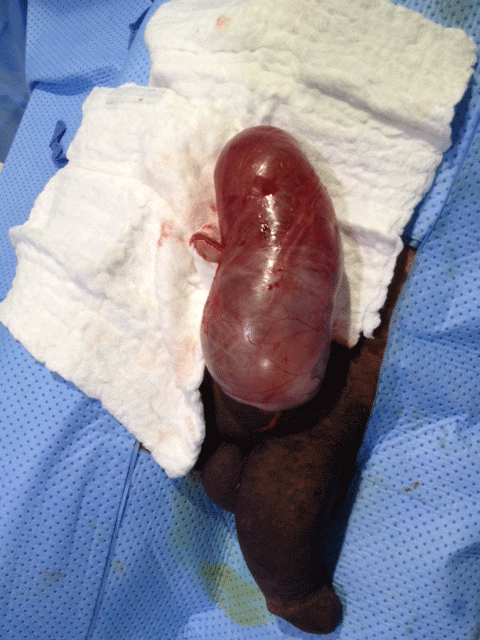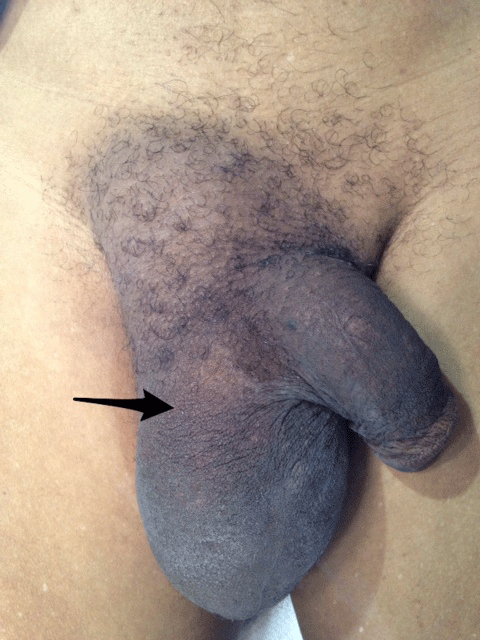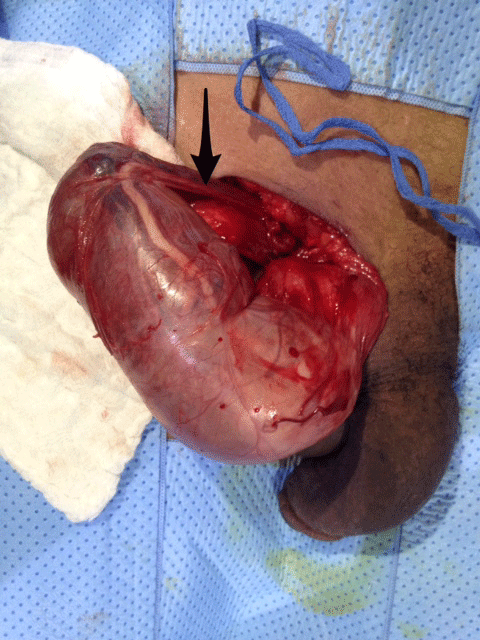A Tunica Vaginalis Hydrocele That You Cannot Get above It at the Scrotal Neck!!?
Atif A Katib1*, Izzeldin A Othman1, Bassem A Dakkak<2, Abdallah M Bawa2 and Mansour S Bashir2
1Urology consultant at King Abdulaziz Hospital, Makkah, Saudi Arabia
2Urology Specialist at King Abdulaziz Hospital, Makkah, Saudi Arabia
*Address for Correspondence: Atif katib, Ministry of health of Saudi Arabia, Saudi Arabia, ORCiD: 0000-0002-0629-2249; Tel: + 0505-507-623; E-mail: [email protected]
Submitted: 08 August 2020; Approved: 14 August 2020; Published: 17 August 2020
Citation this article: Katib AA, Othman IA, Dakkak BA, Bawa AM, Bashir MS. A Tunica Vaginalis Hydrocele That You Cannot Get above It at the Scrotal Neck!!. Int J Case Rep Short Rev. 2020;6(8): 029-031.
Copyright: © 2020 Katib AA, et al. This is an open access article distributed under the Creative Commons Attribution License, which permits unrestricted use, distribution, and reproduction in any medium, provided the original work is properly cited
Keywords: Tunica vaginalis; Hydrocele; Processus vaginalis; Inguinoscrotal swelling; Cystic swelling
Download Fulltext PDF
It has been long taught in the faculty of medicine that scrotal swellings are of two varieties. Pure scrotal swellings that “you can get above it” on manual examination include Tunica Vaginalis (TV) type of hydrocele. Other swellings are inguinoscrotal; that “you cannot get above it”, including indirect inguinal hernia descending to the scrotum. Paradoxically, in our case, we are reporting a non-communicating, TV hydrocele in a 55-year-old man, with no history of scrotal or inguinal surgeries, presented with tense inguinoscrotal swelling extending up to the groin.
Introduction
A 55-year-old man presented to Urology service complaining of right painless genital swelling for six months. The swelling size didn’t change since it started bothering the patient. The patient had no previous scrotal or inguinal surgeries, No urinary complaints. On physical examination, the scrotal swelling is spherical in shape with a waist at the external inguinal ring level, Extending up cylindrically to the internal ring level (Figure 1). The swelling is tense, irreducible, not tender, no cough impulse. The testis and vas couldn`t be palpated above the swelling up to the scrotal neck. The mass has positive translumination, and no bowel sounds could be auscultated. Sonographic examination revealed a single right cystic swelling, filled with clear fluid extending up to the lower abdomen, with normal testis and epididymis [1]. Normal left testis. Operatively, through a right inguinal incision, the mass was delivered intact looking like a butternut pumpkin plant (Figure 2), with no communication to the abdominal cavity (Figure 3). Classic (Lord Procedure) with plication of the tunica sac performed.
Discussion
Commonly, testicular hydroceles in adults are secondary, non-communicating type of hydrocele. It`s pathology is explained as the trapped fluid in the Tunica Vaginalis (TV) is due to imbalance between the secretion/absorption mechanisms; resulting from trauma, tumor or commonly infection. The trapped fluid forms a cystic swelling distal to a supposedly, closed Processus Vaginalis (PV). Typically, the swelling is limited to the scrotum, and “you can get above it” to palpate the cord contents. Traditionally, medical students are taught that TV hydrocele, is a pure scrotal swelling that “you can get above it”; in contrast to oblique inguinal hernia, being the commonest example of inguinoscrotal swellings, that “you cannot get above it” [2]. Embryologically, the case we are reporting represents a possible congenital anomaly in the PV formation [3]. The TV is a mesothelium-lined sac with a visceral layer and a parietal layer. It is formed when the superior portion of the PV closes during embryological development. Short segment of closed PV creates a spacious TV sac extending up through the inguinal canal to end shortly below the internal ring level. In theory, other possible malformations that could happen might include entrapped mesenchymal cells that could lead to lipoma, leiomyoma or sarcoma.
Conclusion
The case we are reporting presents a possible congenital anomaly in the processus vaginalis formation. Medical students should be taught that getting above the hydrocele sac on physical examination is not always the rule; as there are inguinoscrotal vaginal hydroceles which you can get above them in the inguinal region.
- McAchran SE, Dogra V, Resnick MI. Office urologic ultrasound. Urol Clin North Am. 2005; 32: 337-352. DOI: 10.1016/j.ucl.2005.03.005
- Bhosale PR, Patnana M, Viswanathan C, Szklaruk J. The inguinal canal: Anatomy and imaging features of common and uncommon masses. Radiographics. 2008; 28: 819-835. DOI: 10.1148/rg.283075110
- Garriga V, Serrano A, Marin A, Medrano S, Roson N, Pruna X. US of the tunica vaginalis testis: anatomic relationships and pathologic conditions. Radiographics. 2009; 29: 2017-2032. DOI: 10.1148/rg.297095040




Sign up for Article Alerts